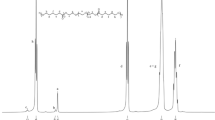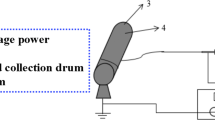Abstract
In order to obtain polymers with preserved thermal properties and tunable biodegradability multiblock copolymers comprising blocks of biodegradable polyesters poly(ε-caprolactone) (PCL) and poly(butylene succinate) (PBS) were successfully synthesized through chain-extension reaction using hexamethylene diisocyanate. Two series of copolymers with different length of PCL block and varying ratio of PCL and PBS block through each series were synthesized. PCL-b-PBS copolymers were characterized by NMR, FTIR, WAXS, DSC, TG and DMA in solid state. Special attention was given to the investigation of the influence of composition and structure of multiblock copolymers on their biodegradability properties. Biodegradability of these multiblock copolymers was assessed through hydrolysis in alkaline medium and soil burial test. Each block in multiblock copolymers crystallized separately, with adverse influence of its presence on degree of crystallinity and, in much lesser extent, on melting temperature of the second phase. Multiblock copolymers showed high thermal stability, comparable to corresponding homopolymers. Mechanical strength, deduced from storage modulus in glassy and rubbery state, was a firm function of composition. Copolymers rich in PBS were more prone to degradation through simple hydrolysis in alkaline medium, while PCL-rich copolymers were more susceptible to degradation by soil microorganisms. Through the change in copolymer composition, degradability in different environments could be tailored without compromising materials’ thermal properties. Besides composition, molecular weight of copolymers had the major influence on degradability properties.














Similar content being viewed by others
References
Larranaga A, Lizundia E (2019) A review on the thermomechanical properties and biodegradation behaviour of polyesters. Eur Polym J 121:109296
Samantaray PK, Little A, Haddleton DM, McNally T, Tan B, Sun Z, Huang W, Ji Y, Wan C (2020) Poly(glycolic acid) (PGA): a versatile building block expanding high performance and sustainable bioplastic applications. Green Chem 22(13):4055–4081
Castro-Aguirre E, Iñiguez-Franco F, Samsudin H, Fang X, Auras R (2016) Poly(lactic acid)-Mass production, processing, industrial applications, and end of life. Adv Drug Deliver Rev 107:333–366
Gigli M, Fabbri M, Lotti N, Gamberini R, Rimini B, Munari A (2016) Poly(butylene succinate)-based polyesters for biomedical applications: A review. Eur Polym J 75:431–460
Woodruff MA, Hutmacher DW (2010) The return of a forgotten polymer-Polycaprolactone in the 21st century. Prog Polym Sci 35(10):1217–1256
Bartnikowski M, Dargaville TR, Ivanovski S, Hutmacher DW (2019) Degradation mechanisms of polycaprolactone in the context of chemistry, geometry and environment. Prog Polym Sci 96:1–20
Vilela C, Sousa AF, Fonseca AC, Serra AC, Coelho JFJ, Freire CSR, Silvestre AJD (2014) The quest for sustainable polyesters – insights into the future. Polym Chem 5(9):3119–3141
Xu J, Guo B-H (2010) Poly(butylene succinate) and its copolymers: Research, development and industrialization. Biotechnol J 5(11):1149–1163
Thakur M, Majid I, Hussain S, Nanda V (2021) Poly(ε-caprolactone): A potential polymer for biodegradable food packaging applications. Packag Technol Sci 34(8):449–461
Di Lorenzo ML (2021) Poly(l-Lactic Acid)/Poly(Butylene Succinate) Biobased Biodegradable Blends. Polym Rev 61:457–492
Su S, Kopitzky R, Tolga S, Kabasci S (2019) Polylactide (PLA) and Its Blends with Poly(butylene succinate) (PBS): A Brief Review. Polymers 11(7):1193
Gumede TP, Luyt AS, Müller AJ (2018) Review on PCL, PBS and PCL/PBS blends containing carbon nanotubes. Express Polym Lett 12(6):505–529
Bikiaris DN (2013) Nanocomposites of aliphatic polyesters: An overview of the effect of different nanofillers on enzymatic hydrolysis and biodegradation of polyesters. Polym Degrad Stabil 98(9):1908–1928
Gonçalves SPC, Martins-Franchetti SM (2010) Action of soil microorganisms on PCL and PHBV blend and films. J Polym Environ 18(4):714–719
Cao A, Okamura T, Ishiguro C, Nakayama K, Inoue Y, Masuda T (2002) Studies on syntheses and physical characterization of biodegradable aliphatic poly(butylene succinate-co-ε-caprolactone)s. Polymer 43(3):671–679
Tserki V, Matzinos P, Pavlidou E, Vachliotis D, Panayiotou C (2006) Biodegradable aliphatic polyesters. Part I. Properties and biodegradation of poly(butylene succinate-co-butylene adipate). Polym Degrad Stabil 91(2):367–376
Safari M, Martínez de Ilarduya A, Mugica A, Zubitur M, Muñoz-Guerra S, Müller AJ (2018) Tuning the Thermal Properties and Morphology of Isodimorphic Poly[(butylene succinate)-ran-(ε-caprolactone)] Copolyesters by Changing Composition, Molecular Weight, and Thermal History. Macromolecules 51(23):9589–9601
Safari M, Otaegi I, Aramburu N, Guerrica-Echevarria G, de Ilarduya AM, Sardon H, Müller AJ (2021) Synthesis, Structure, Crystallization and Mechanical Properties of Isodimorphic PBS-ran-PCL Copolyesters. Polymers 13(14):2263
Fuoco T, Finne-Wistrand A (2019) Enhancing the Properties of Poly(ε-caprolactone) by Simple and Effective Random Copolymerization of ε-Caprolactone with p-Dioxanone. Biomacromol 20(8):3171–3180
Fernández J, Etxeberria A, Sarasua J-R (2015) In vitro degradation studies and mechanical behavior of poly(ε-caprolactone-co-δ-valerolactone) and poly(ε-caprolactone-co-L-lactide) with random and semi-alternating chain microstructures. Eur Polym J 71:585–595
Nikolic MS, Djonlagic J (2001) Synthesis and characterization of biodegradable poly(butylene succinate-co-butylene adipate)s. Polym Degrad Stabil 74(2):263–270
Papageorgiou GZ, Bikiaris DN (2007) Synthesis, Cocrystallization, and Enzymatic Degradation of Novel Poly(butylene-co-propylene succinate) Copolymers. Biomacromol 8(8):2437–2449
Shirahama H, Kawaguchi Y, Aludin MS, Yasuda H (2001) Synthesis and enzymatic degradation of high molecular weight aliphatic polyesters. J Appl Polym Sci 80(3):340–347
Xu C-L, Zeng J-B, Zhu Q-Y, Wang Y-Z (2013) Poly(ethylene succinate)-b-poly(butylene succinate) Multiblock Copolyesters: The Effects of Block Length and Composition on Physical Properties. Ind Eng Chem Res 52(38):13669–13676
Zheng L, Li C, Huang W, Huang X, Zhang D, Guan G, Xiao Y, Wang D (2011) Synthesis of high-impact biodegradable multiblock copolymers comprising of poly(butylene succinate) and poly(1,2-propylene succinate) with hexamethylene diisocyanate as chain extender. Polym Adv Technol 22(2):279–285
Shang Y, Jiang Z, Qiu Z (2021) Synthesis, thermal and mechanical properties of novel biobased, biodegradable and double crystalline Poly(butylene succinate)-b-Poly(butylene sebacate) multiblock copolymers. Polymer 214:123248
Zeng J-B, Li Y-D, Zhu Q-Y, Yang K-K, Wang X-L, Wang Y-Z (2009) A novel biodegradable multiblock poly(ester urethane) containing poly(l-lactic acid) and poly(butylene succinate) blocks. Polymer 50(5):1178–1186
Zheng L, Wang Z, Wu S, Li C, Zhang D, Xiao Y (2013) Novel Poly(butylene fumarate) and Poly(butylene succinate) Multiblock Copolymers Bearing Reactive Carbon-Carbon Double Bonds: Synthesis, Characterization, Cocrystallization, and Properties. Ind Eng Chem Res 52(18):6147–6155
Fabbri M, Gigli M, Gamberini R, Lotti N, Gazzano M, Rimini B, Munari A (2014) Hydrolysable PBS-based poly(ester urethane)s thermoplastic elastomers. Polym Degrad Stabil 108:223–231
Li S-L, Zeng J-B, Wu F, Yang Y, Wang Y-Z (2014) Succinic Acid Based Biodegradable Thermoplastic Poly(ester urethane) Elastomers: Effects of Segment Ratios and Lengths on Physical Properties. Ind Eng Chem Res 53(4):1404–1414
Zhang J, Xu J, Wang H, Jin W, Li J (2009) Synthesis of multiblock thermoplastic elastomers based on biodegradable poly (lactic acid) and polycaprolactone. Mat Sci Eng C 29(3):889–893
Nakayama Y, Okuda S, Yasuda H, Shiono T (2007) Synthesis of multiblock poly(l-lactide)-co-poly(ε-caprolactone) from hydroxy-telechelic prepolymers prepared by using neodymium tetrahydroborate. React Funct Polym 67(9):798–806
Zheng L, Li C, Wang Z, Wang J, Xiao Y, Zhang D, Guan G (2012) Novel Biodegradable and Double Crystalline Multiblock Copolymers Comprising of Poly(butylene succinate) and Poly(ε-caprolactone): Synthesis, Characterization, and Properties. Ind Eng Chem Res 51(21):7264–7272
Xing D-D, Jia Y-W, Li D-F, Wang X-L, Wang Y-Z (2017) Novel Multiblock Poly(ε-caprolactone) Copolyesters Containing D-Glucose Derivatives with Different Bicyclic Structures. ACS Sustain Chem Eng 5(8):7040–7051
Huang M, Dong X, Wang L, Zheng L, Liu G, Gao X, Li C, Müller AJ, Wang D (2018) Reversible Lamellar Periodic Structures Induced by Sequential Crystallization/Melting in PBS-co-PCL Multiblock Copolymer. Macromolecules 51(3):1100–1109
Huang M, Zheng L, Wang L, Dong X, Gao X, Li C, Wang D (2017) Double Crystalline Multiblock Copolymers with Controlling Microstructure for High Shape Memory Fixity and Recovery. ACS Appl Mater Inter 9(35):30046–30055
Sailema-Palate GP, Vidaurre A, Campillo-Fernández AJ, Castilla-Cortázar I (2016) A comparative study on Poly(ε-caprolactone) film degradation at extreme pH values. Polym Degrad Stabil 130:118–125
Dai X, Qiu Z (2017) Crystallization kinetics, morphology, and hydrolytic degradation of novel biobased poly(butylene succinate-co-decamethylene succinate) copolyesters. Polym Degrad Stabil 137:197–204
Khan I, Ray Dutta J, Ganesan R (2017) Lactobacillus sps. lipase mediated poly (ε-caprolactone) degradation. Int J Biol Macromol 95:126–131
Pan W, Bai Z, Su T, Wang Z (2018) Enzymatic degradation of poly(butylene succinate) with different molecular weights by cutinase. Int J Biol Macromol 111:1040–1046
Abe M, Kobayashi K, Honma N, Nakasaki K (2010) Microbial degradation of poly(butylene succinate) by Fusarium solani in soil environments. Polym Degrad Stabil 95(2):138–143
Massardier-Nageotte V, Pestre C, Cruard-Pradet T, Bayard R (2006) Aerobic and anaerobic biodegradability of polymer films and physico-chemical characterization. Polym Degrad Stabil 91(3):620–627
Emadian SM, Onay TT, Demirel B (2017) Biodegradation of bioplastics in natural environments. Waste Manage 59:526–536
Hongsriphan N, Pinpueng A (2019) Properties of Agricultural Films Prepared from Biodegradable Poly(Butylene Succinate) Adding Natural Sorbent and Fertilizer. J Polym Environ 27(2):434–443
Huang J, Cui C, Yan G, Huang J, Zhang M (2016) A Study on Degradation of Composite Material PBS/PCL. Polym Polym Compos 24(2):143–148
Chen S, Ma C, Zhang G (2016) Biodegradable polymers for marine antibiofouling: Poly(ε-caprolactone)/poly(butylene succinate) blend as controlled release system of organic antifoulant. Polymer 90:215–221
Solomon OF, Ciutǎ IZ (1962) Determination of the intrinsic viscosity of polymer solutions by a simple determination of viscosity. J Appl Polym Sci 6(24):683–686
Ihn KJ, Yoo ES, Im SS (1995) Structure and Morphology of Poly(tetramethylene succinate) Crystals. Macromolecules 28(7):2460–2464
Ichikawa Y, Kondo H, Igarashi Y, Noguchi K, Okuyama K, Washiyama J (2000) Crystal structures of α and β forms of poly(tetramethylene succinate). Polymer 41(12):4719–4727
Bittiger H, Marchessault RH, Niegisch WD (1970) Crystal structure of poly-[epsilon]-caprolactone. Acta Crystall B 26(12):1923–1927
Nishide H, Toyota K, Kimura M (1999) Effects of soil temperature and anaerobiosis on degradation of biodegradable plastics in soil and their degrading microorganisms. Soil Sci Plant Nutr 45(4):963–972
Acknowledgements
This work was financially supported by the Ministry of Education, Science and Technological Development of the Republic of Serbia (Contract No. 451-03-68/2022-14/200135).
Author information
Authors and Affiliations
Corresponding author
Ethics declarations
Competing interests
The authors have no relevant financial or non-financial interests to disclose.
Additional information
Publisher's Note
Springer Nature remains neutral with regard to jurisdictional claims in published maps and institutional affiliations.
Supplementary Information
Below is the link to the electronic supplementary material.
Rights and permissions
About this article
Cite this article
Ponjavic, M., Jevtic, S. & Nikolic, M.S. Multiblock copolymers containing poly(butylene succinate) and poly(ε-caprolactone) blocks: Effect of block ratio and length on physical properties and biodegradability. J Polym Res 29, 295 (2022). https://doi.org/10.1007/s10965-022-03144-w
Received:
Accepted:
Published:
DOI: https://doi.org/10.1007/s10965-022-03144-w




